I am often asked to help with other people’s designs, but one of my principles is never to design with cement. Not everyone knows this about me, and I was recently asked what my general experience was with stem walls made of concrete (cement plus aggregate), what are the things to consider or the possible problems with building straw-bales on them. My client went on to say “most of the straw bale builders or straw bale building companies I’ve observed so far in the internet use concrete for their stem walls!? So it seems to work?”
Hmmm. Just because most people do something doesn’t mean it works, or it’s a good idea. This does highlight one of the major problems with cement though, that the problems it causes are not visible or apparent straight away, in fact they can take many years to become obvious. I myself was educated in the use of modern materials and techniques as part of my learning in the construction industry, and I thought, as most people do, that foundations had to be made from cement and bricks had to be laid with a cement mortar. So I know how to lay cement floors and build brick and stone walls, and have done many in my time – but all fortunately now a long time ago.
As I began to learn about natural materials in the 1990s, as well as straw-bale building I studied lime and clay plasters, and cob building. I also had an interest in old houses, and I realised that all our old houses (built before 1900) are built entirely of natural materials, and in fact all old houses everywhere around the world are too. This shows how unbelievable it is that anyone could think that natural materials aren’t durable – but we are all prey to thinking that what everyone does now is better than what people did in the past. There is a common misconception that cement has replaced lime and clay because it does the job better, but I digress…
A major problem with cement and concrete is that it attracts or ‘wicks’ water. If you put a concrete block in an inch of water and leave it for a couple of days, the whole block will get wet. If you stand a piece of wood (or a strawbale) in an inch of water they will both become wet to slightly higher than an inch but no more. They do not wick water. So, using cement for mortars and renders means that when it rains the cement brings the moisture through itself to whatever is behind it. Usually, when it stops raining, most of this dries out again, but not all, and not in damp conditions, or where there is moisture present most of the time. This is why cement should never be used with natural buildings.
In cement foundations, the cement is in contact with the wet earth, so standard practice is to protect the building above from the wet cement by using a damp proof course. More importantly, external walls always contain a certain amount of moisture, due to external rain and internal occupancy (hot showers, cooking etc). In buildings built with cement mortars, this moisture is increased as rain penetrates through the mortar joints. This moisture always travels downwards because of gravity and ends up at the base of the wall. Again, standard practice is to use a cavity tray damp proof course, to direct internal moisture towards the outside of the building. The main reason that people do not realise that cement is actually increasing the moisture content of the building is that the movement of moisture happens very slowly. It can take 30 or 40 years before problems begin to show, which will take the form of moisture build up at the base of the wall, eventually showing as damp problems internally.
When these problems due to the use of cement first started to show, the industry said it was caused by rising damp, and the chemical injection of houses against damp was invented. In fact we now know that there is very little incidence of rising damp, and most damp problems are caused by other things. The Society for the Protection of Ancient Buildings (SPAB) has some excellent research and information on this subject. See http://www.spab.org.uk/advice/technical-qas/technical-qa-20-rising-damp/
Another trend that began was to re-point houses with cement that had been built with lime, and to repair old lime renders with cement renders. No-one knew this was a bad mistake for many many years, because the problems it caused took that long to show. It wasn’t until the spectacular collapse of several cob buildings that had been cement rendered that we started to understand that cement was damaging our buildings, particularly our older ones that were built of natural materials. Again, a sad indicator of why cement should never be used with natural buildings. Today, English Heritage has banned the use of cement on heritage buildings for this reason.
Many modern buildings suffer from condensation problems, and this is a direct result of using cement blocks, mortars and gypsum plasterboard, although this is also because of another of their properties, which is impermeability, they prevent the passage of vapour. This impermeability is another reason why cement should never be used with natural buildings. Lime and clay on the other hand actually regulate humidity and can hold excess moisture within themselves without becoming ‘wet’ and release it as humidity levels drop – they are hygroscopic. This also helps to keep indoor air quality healthy. Lime used as mortar or render outside absorbs water when it rains, and as it becomes saturated this actually prevents moisture passing through it and so it protects the building behind it. When it stops raining, this moisture is released into the atmosphere.
So I return to my client’s question. The fact that so many people use cement does not mean that it “works”! It simply means lack of awareness. Most people are not designing for a 200 year life, as we do. What we see is that houses built in the 1970s (out of cement) are being pulled down and deemed not fit for habitation, when houses built by the Victorians or earlier (cement started being used widely in construction after the first world war) are being renovated (oh no, often with cement) and continue to give good service… until the effects of new gypsum plaster or cement pointing start to cause damp or condensation problems.
Finally, there are many ways to build foundations that do not require cement. All our old houses have foundations with no cement – how could they be otherwise? I have designed several types of foundations that do not need cement, these are available for anyone to use on our website in the Free Information section. All these designs are legal, are approved by Planners and meet current Building Regulations.
I recommend everyone to begin to understand the wonders of lime and clay. I expect that if you do then like me you’ll want to become a Natural Builder!
If you’re interested in learning more about cement and what causes the problems it suffers, here are three blog posts I’d recommend:
http://surveyingproperty.blogspot.co.uk/2014/11/concrete-part-2-carbonation.html#.VGyGWfmsWxI
Thanks to Oliver at Naturalhomes.org for the image.
 Interested in learning more about straw-bale building from Barbara Jones?
Interested in learning more about straw-bale building from Barbara Jones?
Barbara Jones is the star of our straw-bale building online course. The course contains a range of documents and videos, covering all aspects of straw-bale building, from foundations, walls and roofs to tools, internal fittings and plastering, with lots of tips and inside information. Priced at just £30 for lifetime access, it’s our most popular online course to date.

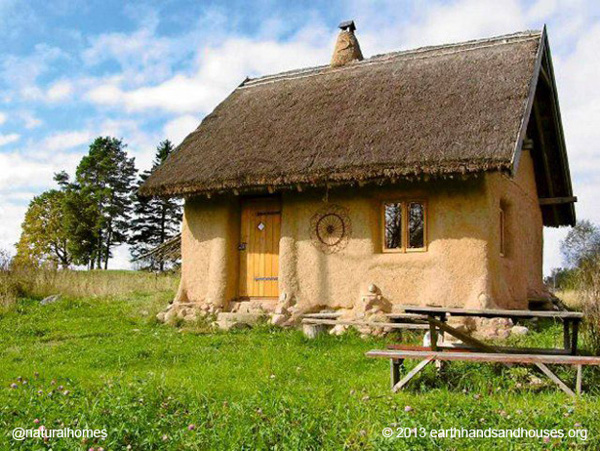
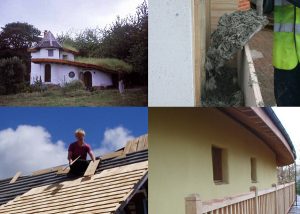
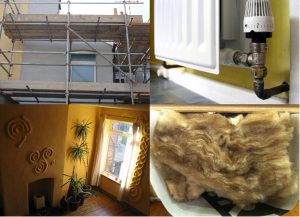

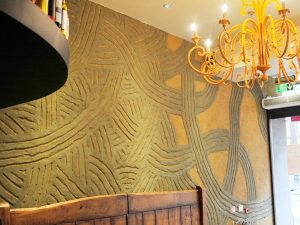

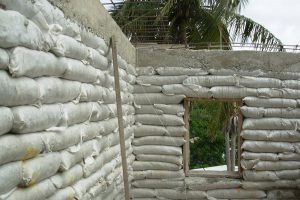
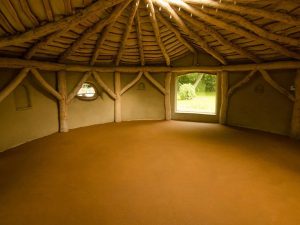

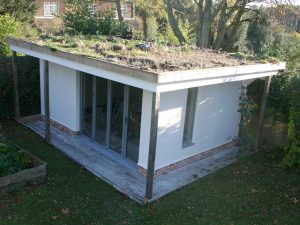
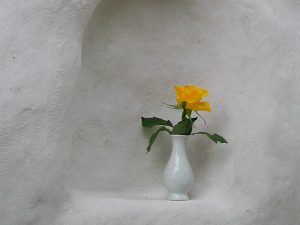
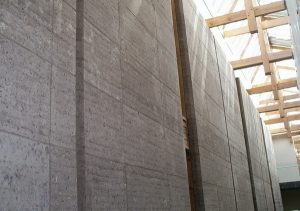
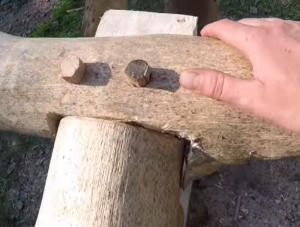
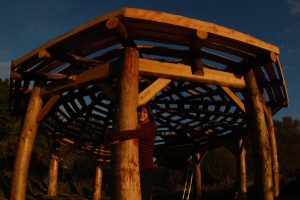
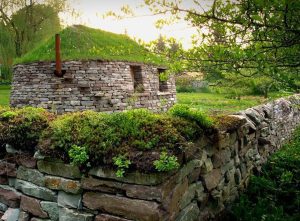
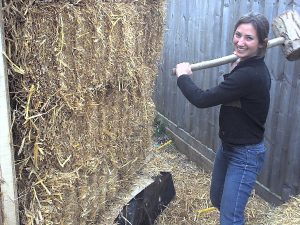
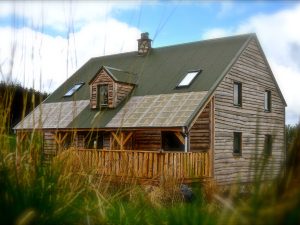
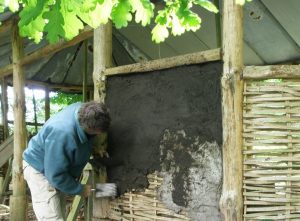
21 Comments
Yes yes yes! Completely agree. Portland cement, the most useless, ugly building material with the highest carbon footprint going. But hey, it’s big business.
Please look at ‘ Arcuus eco building method ‘ on youtube. This technique addresses the need for mass production of durable shelter using recycled material.
Building has become about selling materials and products required by ever more complicated building codes. Simple techniques and materials are ignored purely for profit.
Big business is king.
Environmental costs of manufacturing and distributing unneccessary materials, and disposal of these after a short life are massive and unsustainable. Building techniques and materials must be simplified but often cannot easily meet silly inflexible codes.
People before profit.
Beautifully put. (you too Atulya)
The Greeks used volcanic tuff from the island of Thera as their pozzolan and the Romans used crushed volcanic ash (activated aluminium silicates) with lime. This mixture was able to set under water increasing its resistance.[clarification needed] The material was called pozzolana from the town of Pozzuoli, west of Naples where volcanic ash was extracted.[9] In the absence of pozzolanic ash, the Romans used powdered brick or pottery as a substitute and they may have used crushed tiles for this purpose before discovering natural sources near Rome.[5] The huge dome of the Pantheon in Rome and the massive Baths of Caracalla are examples of ancient structures made from these concretes, many of which are still standing.[10] The vast system of Roman aqueducts also made extensive use of hydraulic cement.[11] and personally i live in a 500 year old house build with bricks stones and cement and it doesnt look like its about to fall 😉
Hi Paolo. If your house is 500 years old, it wasn’t built with cement, it was built with lime. Cement was developed from lime, with additives that allowed it to set without having to take carbon from the air, in the 19th century. It really took off in the 20th century though.
Those Roman domes were lime with pozzolans – and a great advert for lime they are too.
See http://lowimpactorg.wpengine.com/lowimpact-topic/lime/
I’ve worked with lime mortar before, when I had to re-point a large old sandstone wall. Partly I did this because I couldn’t find a local builder who knew that portland cement would in time eat away at the stone, partly also I wanted to do the job myself. So, yes, education is definitely needed here.
What I found was that a lot of the lime mortar didn’t set. I was working on the job over a number of years because of this, and even if I re-pointed in late Spring, by the time that the Autumn rain and then early frosts came, the lime mortar would just crumble away.
I’ve read one of your books Barbara, and I enjoyed it, but one question that remains to me is how to overcome this slow setting speed of lime mortar in a wet climate. This appears to be particularly relevant to the external rendering on a straw-bale house, where it is necessary to stop water ingress from rain lashing in.
I also knew about the Roman’s being able to make long-lasting, underwater cement. It is very interesting. Related to this, I have worked near to 15th Century river embankments that were made with stone and lime mortar. I’ve no idea how these engineers could have done this due to the need for slow setting. Can anyone suggest an explanation?
It is important also to be clear on the definition of “cement”. Cement is just a binding matrix. There are geological cements for example in volcanic and sedimentary rocks. What people mean by modern cement is the Portland type.
Hi Andrew. Lime sets by taking carbon from the air, to become calcium carbonate again – i.e what it was before it was burnt. In wet conditions, and of course underwater, it’s not able to get to the air to get the carbon. The Romans introduced impurities to the lime, so that it could set using elements from the impurities, and didn’t need the carbon from the air (e.g. calcium silicate could be formed, amongst others).
This ‘impure’ lime became hydraulic lime – and strongly hydraulic lime can set underwater.
The wetter the conditions, the more hydraulic the lime needs to be (but it’s less environmentally-friendly / carbon neutral, because it doesn’t take carbon from the air).
We rendered straw bale buildings and they were completely set in a week.
Portland cement was developed from extremely hydraulic lime – and it doesn’t take any carbon from the air at all.
More here – http://lowimpactorg.wpengine.com/category/lime/?post_type=infoarticle
cheers
Hi Andrew. If your lime mortar didn’t set then I’d question what ‘lime’ you were using. The fat limes, or air limes, made from lime putty, will harden within 4 days as a render, usually faster than that as a mortar. Hydraulic limes will set sooner, so if your lime never set, then it sounds like you were using either bagged hydrate lime (developed for the modern construction industry as an additive to cement, to make it behave more like lime ie be sticky) or an old bag of hydraulic lime which did not have enough active lime left in it.
Lime does not have a slow setting speed. It takes longer to harden than cement, and to reach its strength, but it will be hard to the touch within 4 days. If it does not, there’s something wrong with the choice of lime. As Dave says above, the eminently hydraulic limes eg NHL5 will set underwater. Some types of lime eg Prompt cement (actually lime not Portland cement) will set within an hour or so.
Eminently! That’s the word I was looking for.
Thanks Barbara and Dave,
I tried mixing my own first, and had little success. I then bought some in from a company who specialised in stone wall render and mortar. The wall was a 20 ft retaining wall, so it was subject to dampness. The mortar harnened but never fully “set” sufficiently to protect it against the wet Autumn (which soaked it) and then the early frosts.
It seems therefore that my knoweldge of the mixture was lacking.
Is there such as thing as an expert’s guide to mixing lime mortar and render, or have these old chemical skills been lost in part? I’ve read the basic stuff but if there had been something more detailed then it would have helped. I suspect this is also holding back builders taking on more sustainable methods.
Andrew
Hi Andrew. It’s pretty much all here, in the various pages – http://lowimpactorg.wpengine.com/category/lime/?post_type=infoarticle
D
hi i am trying to find a structural engineer to sign off a lime-crete raft foundation design that i can use for a roundhouse but everyone says it must be portland cement concrete or they won’t touch it. help!
Hi – if you put something at the bottom of the low-impact building, lime and roundhouses topics, it’s more likely to be seen by someone who could help you (blog articles slip back in time, but the topics are permanent). Meanwhile, I’ve sent your email to a couple of people who might be able to help you. cheers.
Hi, you mention more Information about Foundation alternatives in the Free Section, but closest I could find was 1 article on the Tyres used in a foundation.. Please could you assist with some kind of link to a Section or such where this Info can be viewed?
AJ – two pdfs here – http://strawworks.co.uk/technical/ – with details of insulated foundations with clay soil and good bearing soil, plus one on car tyre foundations in the text below, which you might have seen already.
Cement is the main culprit of killing all the rivers in the nature (the River Sand Usage)
Wow, thank goodness you reminded us not to use cement renders on old structures to prevent further damage. One of the houses in my neighborhood was built in the 19th century and is gonna be restored this fall. I hope those in charge of the project would remember this tip when finding a cement company to help. https://www.texturecoatingqld.com.au/our-services
I am very confused, because from my understanding of the definition of what a cement is, lime is a cement. There are a lot of concrete recipes published online using various cements but they are usually lime based, some are even based on Roman concrete. Can you give a more detailed definition of what you mean by cement, and what forms of cement, like lime, are still okay to incorporate into buildings without risking the damp seeping into the building and causing mould and crumbling foundations and which ones should be always avoided?
That is BS. Tell it to the Romans who’s concrete buildings are still standing 2500 years later.
Megan / GF – Roman cement was very different from modern cement. See https://www.lowimpact.org/categories/lime
Modern cement contains non-natural, non-breathable additives that Roman cement didn’t. The modern cement industry is one of the biggest emitters of CO2.
GF – See above. plus the article is about why non-breathable modern cement is bad for natural buildings, not how durable it is. And please don’t be rude.
It’s refreshing to see someone advocating against the conventional use of cement in construction, especially in natural building practices. Cement’s ability to attract and retain water can lead to long-term structural issues like dampness and condensation, which are often overlooked until they become significant problems. Your insights into the historical and practical implications of using cement versus natural materials highlight the importance of sustainable building practices that prioritize longevity and environmental harmony.